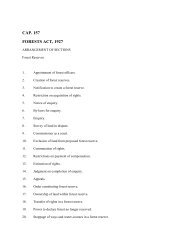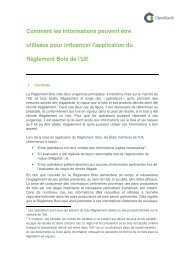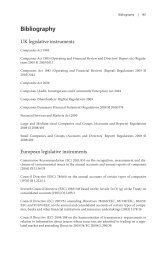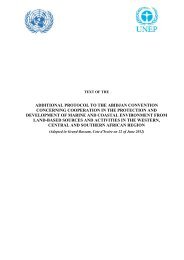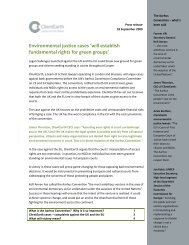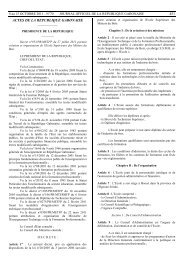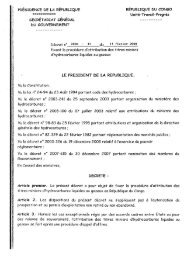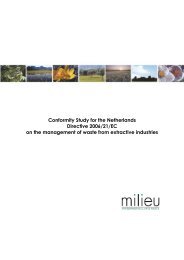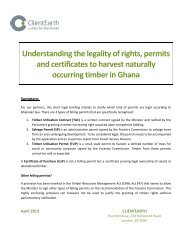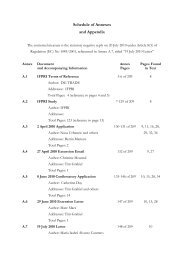Environmental and social transparency under the ... - ClientEarth
Environmental and social transparency under the ... - ClientEarth
Environmental and social transparency under the ... - ClientEarth
- No tags were found...
Create successful ePaper yourself
Turn your PDF publications into a flip-book with our unique Google optimized e-Paper software.
112 | <strong>Environmental</strong> <strong>and</strong> <strong>social</strong> <strong>transparency</strong> <strong>under</strong> <strong>the</strong> Companies Act 2006Annex 4: Auditing of company environmental <strong>and</strong> <strong>social</strong> accounting <strong>and</strong> reporting | 113(3) If so required, <strong>the</strong> parent company must take all such steps as are reasonablyopen to it to obtain <strong>the</strong> information or explanations from <strong>the</strong> person concerned.(4) A statement made by a person in response to a requirement <strong>under</strong> this sectionmay not be used in evidence against him in criminal proceedings except proceedingsfor an offence <strong>under</strong> section 501.(5) Nothing in this section compels a person to disclose information in respect ofwhich a claim to legal professional privilege (in Scotl<strong>and</strong>, to confidentiality ofcommunications) could be maintained in legal proceedings.Auditors also have <strong>the</strong> right to oblige parent companies to take all stepsthat are ‘reasonably open to it’ to secure any information or explanationsthat are necessary for <strong>the</strong> purposes of <strong>the</strong> audit from a subsidiary (oremployee of that subsidiary) not subject to UK law.s502 Auditor’s rights in relation to resolutions <strong>and</strong> meetings(1) In relation to a written resolution proposed to be agreed to by a private company,<strong>the</strong> company’s auditor is entitled to receive all such communications relating to<strong>the</strong> resolution as, by virtue of any provision of Chapter 2 of Part 13 of this Act,are required to be supplied to a member of <strong>the</strong> company.(2) A company’s auditor is entitled—(a) to receive all notices of, <strong>and</strong> o<strong>the</strong>r communications relating to, any generalmeeting which a member of <strong>the</strong> company is entitled to receive,(b) to attend any general meeting of <strong>the</strong> company, <strong>and</strong>(c) to be heard at any general meeting which he attends on any part of <strong>the</strong>business of <strong>the</strong> meeting which concerns him as auditor.(3) Where <strong>the</strong> auditor is a firm, <strong>the</strong> right to attend or be heard at a meeting is exercisableby an individual authorised by <strong>the</strong> firm in writing to act as its representativeat <strong>the</strong> meeting.Auditors also have considerable rights relating to company general meetings.They are entitled: to receive notice of any meeting; to receive allcommunications relating to a meeting; to attend any meeting; to be heardat any meeting; <strong>and</strong> to appoint a representative to exercise out any of thoserights.A.4.1.3Requirements for <strong>the</strong> auditor’s reports495 Auditor’s report on company’s annual accounts(1) A company’s auditor must make a report to <strong>the</strong> company’s members on all annualaccounts of <strong>the</strong> company of which copies are, during his tenure of office—(a) in <strong>the</strong> case of a private company, to be sent out to members <strong>under</strong> section423;(b)in <strong>the</strong> case of a public company, to be laid before <strong>the</strong> company in generalmeeting <strong>under</strong> section 437.The auditor must make a report, which must accompany <strong>the</strong> company’sannual accounts <strong>and</strong> reports. The auditor’s report must satisfy a numberof requirements.Annual accountss495 Auditor’s report on company’s annual accounts(2) The auditor’s report must include—(a) an introduction identifying <strong>the</strong> annual accounts that are <strong>the</strong> subject of <strong>the</strong>audit <strong>and</strong> <strong>the</strong> financial reporting framework that has been applied in <strong>the</strong>irpreparation, <strong>and</strong>(b) a description of <strong>the</strong> scope of <strong>the</strong> audit identifying <strong>the</strong> auditing st<strong>and</strong>ards inaccordance with which <strong>the</strong> audit was conducted.(3) The report must state clearly whe<strong>the</strong>r, in <strong>the</strong> auditor’s opinion, <strong>the</strong> annualaccounts—(a) give a true <strong>and</strong> fair view—(i) in <strong>the</strong> case of an individual balance sheet, of <strong>the</strong> state of affairs of <strong>the</strong>company as at <strong>the</strong> end of <strong>the</strong> financial year,(ii) in <strong>the</strong> case of an individual profit <strong>and</strong> loss account, of <strong>the</strong> profit orloss of <strong>the</strong> company for <strong>the</strong> financial year,(iii) in <strong>the</strong> case of group accounts, of <strong>the</strong> state of affairs as at <strong>the</strong> end of<strong>the</strong> financial year <strong>and</strong> of <strong>the</strong> profit or loss for <strong>the</strong> financial year of<strong>the</strong> <strong>under</strong>takings included in <strong>the</strong> consolidation as a whole, so far asconcerns members of <strong>the</strong> company;(b) have been properly prepared in accordance with <strong>the</strong> relevant financial(c)reporting framework; <strong>and</strong>have been prepared in accordance with <strong>the</strong> requirements of this Act (<strong>and</strong>,where applicable, Article 4 of <strong>the</strong> IAS Regulation).Expressions used in this subsection that are defined for <strong>the</strong> purposes of Part 15(see section 474) have <strong>the</strong> same meaning as in that Part.(4) The auditor’s report—(a) must be ei<strong>the</strong>r unqualified or qualified, <strong>and</strong>(b) must include a reference to any matters to which <strong>the</strong> auditor wishes to drawattention by way of emphasis without qualifying <strong>the</strong> report.The auditor’s report must identify <strong>the</strong> annual accounts being audited, <strong>and</strong>which financial reporting framework was used to prepare <strong>the</strong>m. It mustalso describe <strong>the</strong> scope of <strong>the</strong> audit, <strong>and</strong> <strong>the</strong> auditing st<strong>and</strong>ards which wereapplied in carrying it out. The auditor’s report must ei<strong>the</strong>r be unqualified(i.e. state that <strong>the</strong> financial statements give a true <strong>and</strong> fair view), orqualified (state a significant disagreement with <strong>the</strong> disclosures made ortechniques employed, or opinion that <strong>the</strong> audit has been too limited in



